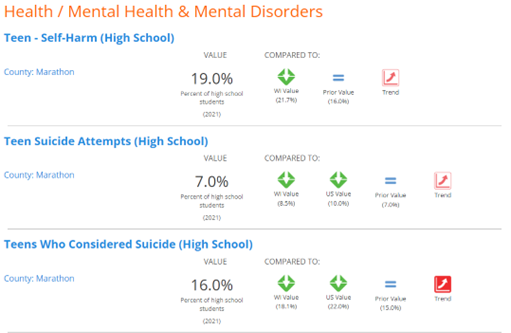Youth Risk Behavior Survey (YRBS) County-Level Reporting and Dissemination
Coalitions That Adopted
Healthy Teen Minds – Calumet, Outagamie, and Winnebago Counties
Marathon County School-based Counseling Consortium – Marathon County
Mental Health Matters, Chippewa Valley – Chippewa & Eau Claire Counties
Strategy Type
School-Based & Resources/AccessStrategy Goal
Improve youth mental health and influence policy change by making consistent data reporting more digestible, accessible, and usable by schools, districts, local health departments, non-profit organizations, and the community members.
Intended Population
Administrators and decision makers in community-based organizations and coalitions, government, healthcare institutions, and Wisconsin’s public middle and high schools.Strategy Background
Throughout Wisconsin and across the United States, localized data on youth mental health can be difficult to find and is not always made available. Data plays a crucial role in understanding the scope and nature of mental health among young people, identifying risk factors and disparities, applying for grants, evaluating intervention strategies, and monitoring the outcomes of those strategies. Without adequate data, it can be difficult to implement evidence-based policies and interventions to address mental health problems.
Four Wisconsin-based coalitions from La Crosse County; Calumet, Outagamie and Winnebago Counties; Marathon County; and Chippewa and Eau Claire Counties have each worked to address this data shortage by creating and disseminating county-level data reports and scorecards in their communities. The data comes from the Youth Risk Behavior Survey (YRBS), a biennial survey conducted in middle and high schools across the country, measuring six key categories of health-related behaviors and attitudes that contribute to the leading causes of death and disability among youth and adults.
The YRBS is a rich data source that can be used to guide strategy, policy and decision making to address youth mental health. The survey’s validated information has been consistently used by schools, health and community organizations over the span of 30 years, allowing them to measure trends and develop strategies to address issues that impact youth.
 While the YRBS has been conducted in areas of Wisconsin since 1993, improvements in recent years have made it more accessible and convenient for schools to administer the survey. Changes include the addition of questions surrounding anxiety, sleep, and gender; the standardization of questions across four distinct modules; and transitioning the survey to a digital setting. In Spring of 2019, the Wisconsin Department of Public Instruction (DPI) implemented a new YRBS online system that streamlined statewide data collection and reporting. With this change, DPI was able to produce standardized county-level reports for all counties with sufficient levels of participation. Additionally, the DPI standardized the timeframe of all future surveys – now conducted in spring semesters of odd-numbered years.
While the YRBS has been conducted in areas of Wisconsin since 1993, improvements in recent years have made it more accessible and convenient for schools to administer the survey. Changes include the addition of questions surrounding anxiety, sleep, and gender; the standardization of questions across four distinct modules; and transitioning the survey to a digital setting. In Spring of 2019, the Wisconsin Department of Public Instruction (DPI) implemented a new YRBS online system that streamlined statewide data collection and reporting. With this change, DPI was able to produce standardized county-level reports for all counties with sufficient levels of participation. Additionally, the DPI standardized the timeframe of all future surveys – now conducted in spring semesters of odd-numbered years.
Today, the data published by DPI includes hundreds of quality checks used to identify and remove likely invalid responses, which help to ensure that data used for reports is as clean as possible. The many changes and improvements instituted by DPI have created a clear, consistent, and effective system for Wisconsin YRBS data collection, which will drive data dissemination and decision-making in the future.
In 2021, 53 of Wisconsin’s 72 counties received a county-level high school report and 43 received a county-level middle school report. That means over a quarter of Wisconsin counties do not have data available to them because their schools do not participate in the YRBS or did not have adequate participation rates. The YRBS remains one of the best population-level data sources for communities. A better understanding of the capabilities stemming from YRBS data collection can create a more fluid process of addressing mental and behavioral health in today’s youth, and ultimately improve outcomes.


